Are You Making The Most Of Your Gym Membership?
Not if you’re using the same equipment all the time. Use this guide to fitness kit and find the right tool for the right job
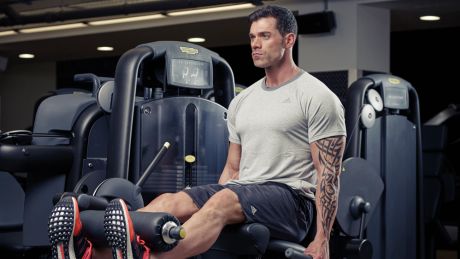
Kettlebells
Key moves Swing, clean, snatch
Essential info Kettlebells were originally used by old-school Russian strongmen but came into training fashion in the West about a decade ago. A standard kettlebell weighs 16kg and they usually go up in increments of 4kg. Kettlebell sport competitions focus on feats of strength endurance, such as maximum snatch reps in ten minutes, but they can also be used in standard home and gym workouts.
Pros Most of the key kettlebell exercises, like swing variations and snatches, involve large movements that require good stability and co-ordination, so they’re excellent at improving dynamic strength.
The big movements and extended work sets that are often used in kettlebell training will also increase your cardiovascular fitness, so they’re useful if you’re not a fan of traditional cardio. They’re compact and versatile, which makes them a good home workout option, particularly if space and cash are limited.
RECOMMENDED: Kettlebell Workouts For Strength, Cardio And Fat Loss
Cons If adding maximum muscle in minimum time is your aim, a kettlebell isn’t your go-to tool. That doesn’t mean you can’t add muscle by using a kettlebell, but the dynamic, multi-joint moves make it difficult to really isolate muscles, which is a key element in maximising their size.
You wouldn’t, for example, use a kettlebell to perform a set of biceps curls. Some moves, such as windmills, can be difficult to execute and offer a fast track to injury if performed poorly but when you do them properly, they’re perfectly safe.
Get the Coach Newsletter
Sign up for workout ideas, training advice, reviews of the latest gear and more.
Dumbbells
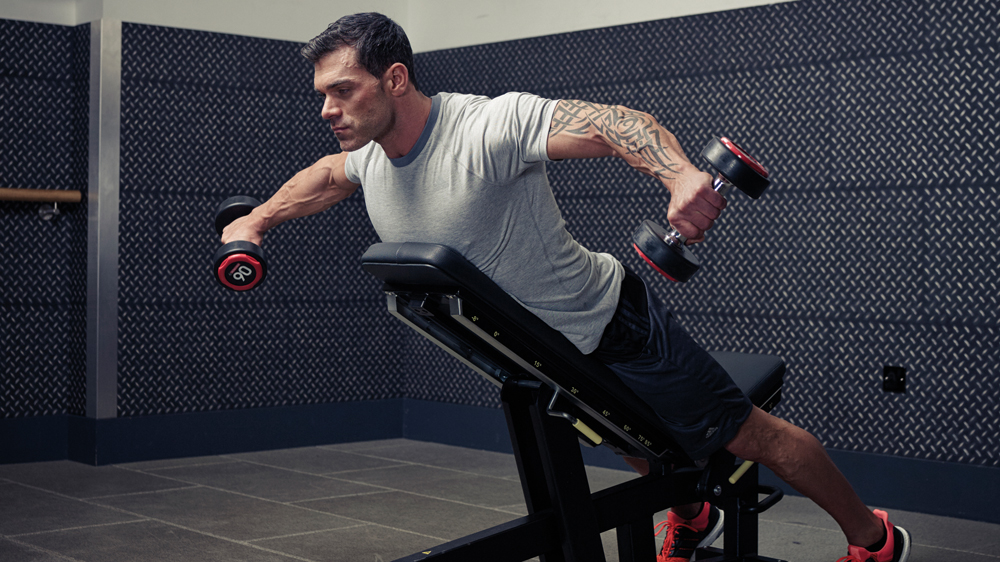
Key moves Biceps curl, shoulder press, lateral raise
Essential info Dumbbells are the most instantly recognisable piece of gym equipment. This type of free weight is found not only in every single gym across the land, but also most people’s homes – either in regular use in the home gym or garage, or hidden away under the bed. They can be used for single-arm work, held in both hands, or as a pair as an alternative to barbells.
RECOMMENDED: The Best Dumbbells For Home
Pros The beauty of dumbbells is that a simple set provides a pretty thorough home-workout routine: you can work almost every muscle group with a well-designed dumbbell-only programme.
RECOMMENDED: The 4-Week Dumbbell Workout Plan To Build Muscle At Home
In gyms they come in increments of either 1kg or 2.5kg, ranging from very light to very heavy, and so can be used by all ability levels. They are perfect for unilateral (single-sided) exercises; they work the small, stabilising muscles of the joints more than barbells do; and they’re useful for highlighting any strength imbalances between your dominant and weaker side, which are harder to ascertain with a barbell. This enables you to correct any muscular weaknesses.
Cons You can’t lift the same total weight with dumbbells as you can with a barbell, or most other kit. This is mainly because you will be limited by your weaker limb, and because those stabilising muscles play a bigger role in dumbbell lifts, which reduces your total strength output.
If your gym has dumbbells that increase in 2.5kg increments then moving up a weight is a big jump, which might mean you have to reduce the reps you lift per set significantly.
RECOMMENDED: All Dumbbell Exercises
Suspension trainer
Key moves Incline press-up, inverted row, chin-up
Essential info First used by the US military – initially in submarines, where workout space and kit are limited, and then becoming more widespread – suspension training uses your bodyweight to build strength, stamina, balance, flexibility and joint stability through two handles, suspended on rope, that allow a wide range of compound exercises.
RECOMMENDED: Two Suspension Training Workouts to Build Functional Fitness
Pros Suspension training allows you to work your back and biceps muscles using only your bodyweight as resistance, something that’s impossible to do at home unless you have a pull-up bar. This means you can work all your major muscle groups either at home or on your travels. They also require your core and stabilising muscles to work hard to support your weight, when doing both upper- and lower-body exercises, and they also improve joint strength and stability, which can safeguard against injury.
RECOMMENDED: The Ultimate TRX Workouts
Cons Bodyweight moves might sound easy, but doing press-ups with your hands or feet suspended off the ground is a whole lot harder than resting on the floor, so you might have to go back to basics and re-master the main bodyweight moves before trying them on suspension ropes.
While the use of bands and gravity can add up to make some moves pretty tough, the resistance your muscles have to manage is ultimately limited by how much you weigh, especially when training your legs, so you’ll need to use other, heavier kit options if you want to add as much size as possible.
RECOMMENDED: The Beginner’s Guide To TRX Training
EZ-bar
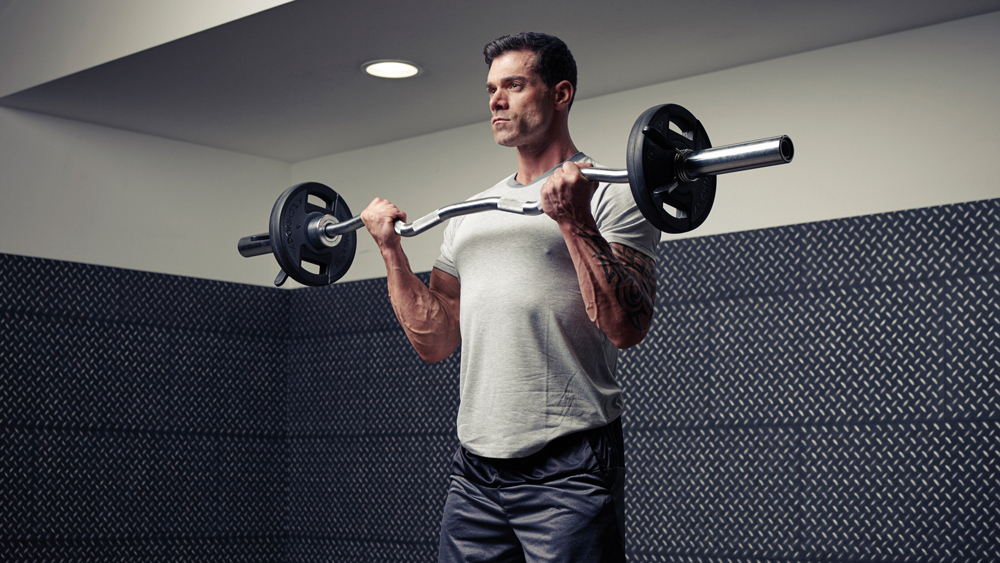
Key moves Biceps curls, lying triceps extension, upright row
Essential info EZ-bars are a type of barbell but shorter in length and with an undulating middle section that is ergonomically designed for a grip that reduces strain and pressure on your wrists and elbows.
For this reason they are most commonly used for biceps and triceps exercises, because their design allows a heavier weight to be lifted comfortably and without placing excess pressure on the wrist joint. EZ-bars, like barbells, come in two varieties: fixed, where the weight can’t be changed; or an empty bar to which you can add weight plates to increase the amount of resistance.
Pros Their design allows a semi-supinated grip, because your hands are halfway between palms facing up (supinated grip) and palms facing one another (neutral grip). This means you can effectively isolate individual muscles, specifically the biceps and triceps, with a heavy weight without comprising joint safety.
They also facilitate a greater range of motion (which is essential for maximum muscle growth), especially for the biceps when used on a preacher curl bench, because of the way the bar keeps your wrists turned in and your elbows turned out for a more fluid and full movement pattern. EZ-bars are also suited to upright row movements, again thanks to the ergonomic gripping section of the bar which allows a smoother, more natural movement than you can achieve with a straight barbell.
Cons The only real downside to EZ-bars is that they are still surprisingly rare in most gyms, meaning you have no choice but to use dumbbells or straight barbells.
Barbell
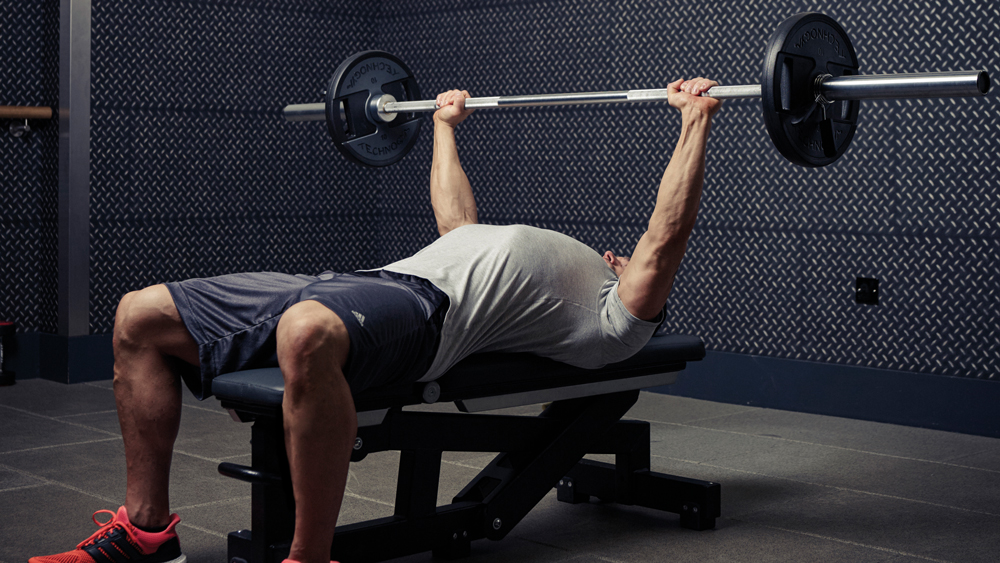
Key moves Bench press, deadlift, squat
Essential info If your gym doesn’t have barbells, you need to double-check that you’re actually in a gym. Barbells are most suited to compound or multi-joint lifts like the bench press, overhead press, squat, deadlift and bent-over row, because they allow for the heaviest amount of weight to be lifted safely.
They come in two forms: Olympic bars and regular “fixed” barbells. An Olympic barbell is 7ft (2.13m) long and weighs 20kg. Regular bars are nearly always shorter and lighter, and often are fixed with a set weight that can’t be adjusted, with bars typically increasing in weight in 2.5kg or 5kg increments.
RECOMMENDED: 7 Essential Barbell Moves To Get Stronger
Pros Olympic barbells are ideal for the heavy compound lifts that are the cornerstone of any training routine designed to build muscle size and strength. The middle section of an Olympic bar (the part you grip) is an inch thick and has a “knurled” surface that allows for a very secure grip. Each end is two inches (5cm) thick and revolves, which allows the weight plates to rotate as you lift and lower the bar, reducing stress on your wrist and elbow joints, especially when lifting heavy.
RECOMMENDED: Barbell Workouts To Burn Fat Fast
Cons Barbells aren’t very beginner-friendly because a good understanding of correct form is essential for barbell lifts, especially as the weight gets heavier, to minimise the risk of injury.
Fixed-weight bars, which are far more common in most gyms, have non-revolving ends and this makes them harder to handle on more complex lifts, because they don’t allow for the smoothest movement patterns; this can cause joint stress, especially with heavier bars.
Although it’s still relatively quick and easy to adjust the amount of weight on an Olympic bar, it takes longer than with all other kit, which makes barbells far from ideal for effective drop sets, unless you have spotters to help out.
A more common problem, however, is that many gyms have a limited number of barbells so you might have to wait for an Olympic one, or the fixed one at the weight you need, to become available.
RECOMMENDED: All Barbell Exercises
Cable machine
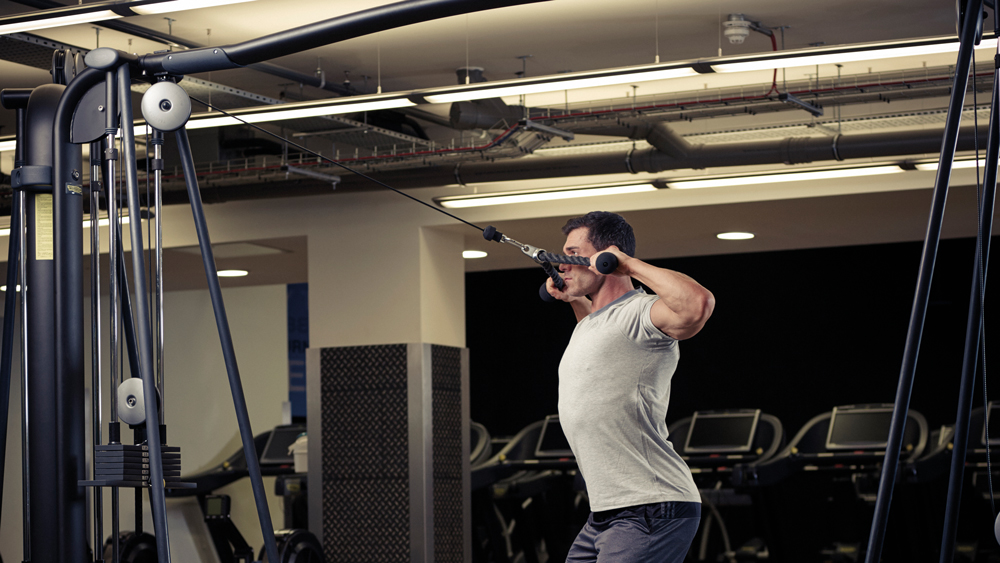
Key moves Triceps press-down, cable cross-over, cable face pull
Essential info Cable machines are a halfway house between resistance machines and free weights because movement patterns are restricted, but not completely fixed, thanks to a rotatable joint attached to the top and bottom of the pulley system. This allows you to isolate specific muscles safely, while also having to engage and activate secondary muscles and stabilising muscles.
Pros Because you can attach different handles to a cable machine, you can use it for a wide variety of pushing, pulling and rotational exercises. What’s more, these machines maintain equal tension on the working muscle or muscles during the entire lifting and lowering phase of each rep in a way that barbells and dumbbells don’t, which forces your muscles to work harder through a set to manage the weight. They are also ideal for direct abs work, particularly rotational movements to work your deep underlying core muscles and obliques.
RECOMMENDED: Cable Machine Exercises for Abs
Cons Most gyms will have one cable machine or none, so either you may not have the opportunity to use it or will have to wait a while for your turn. A lot of exercises that use this machine involve a significant range of motion of the shoulder joint, so you need to have strong and stable shoulders to avoid injury. In fact the machine might be best avoided altogether if you are recently returning from a shoulder injury, unless using it for rehab purposes.
RECOMMENDED: All Cable Machine Exercises
Resistance machines
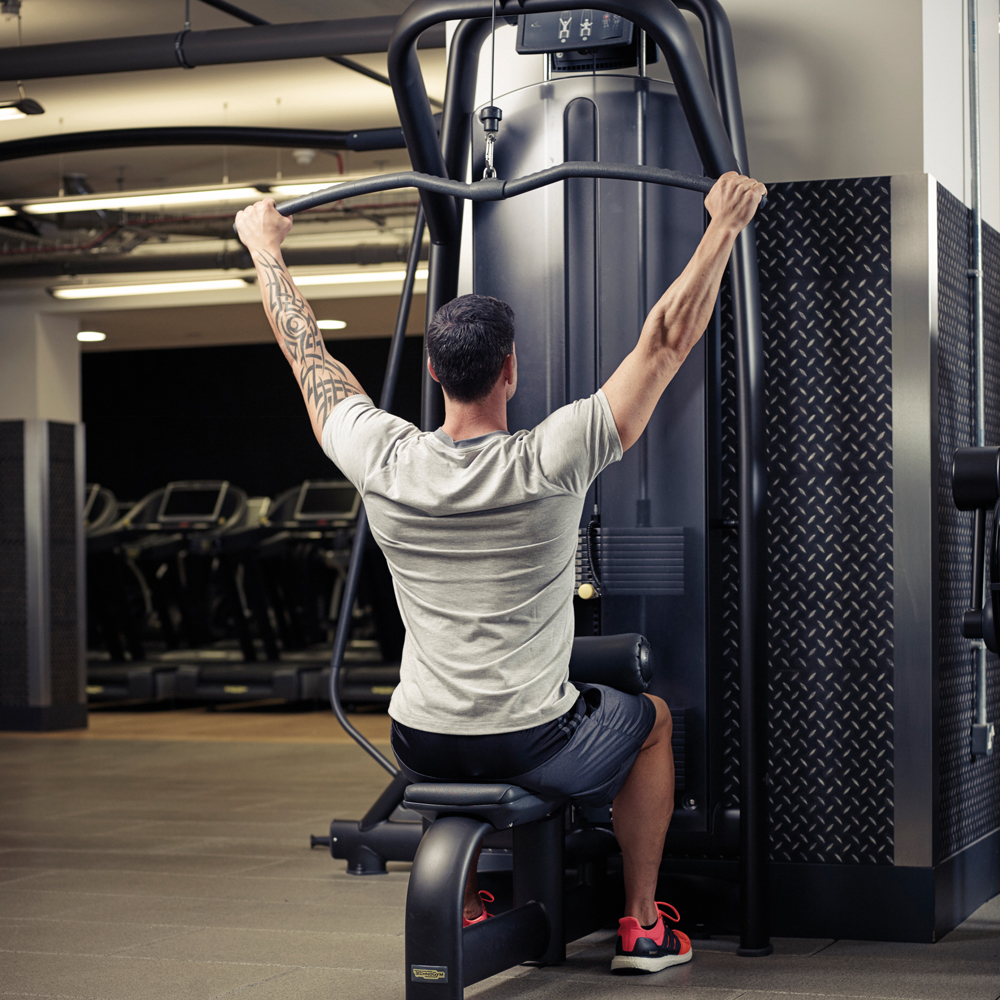
Key moves Lat pull-down, chest press, seated row
Essential info Most gyms have resistance machines that work all the major muscle groups, but the main criticism levelled at these bits of kit is that they’re not as effective as free weights when training for improvements in muscular size and strength.
That’s because they only allow fixed movement patterns that don’t engage your core or the small but important stabilising muscles of your joints. However, it is for this very reason that they’re useful in some ways for both beginners and advanced lifters alike.
Pros Resistance machines only allow movement in a fixed pattern, which makes them ideal for beginners or those coming back from an injury, who need to master a correct and safe movement pattern before advancing to more challenging barbell and dumbbell moves.
They’re also useful for people who want to isolate a specific muscle because the fixed movement of the machine doesn’t recruit the stabilising muscles – nearly always the weak link that limits the weight that can be moved – so you can lift heavy in the safest possible way to maximise muscle growth. You can also adjust the weight you are lifting quickly and easily.
Cons Because they don’t require the activation or engagement of any of the important stabilising muscles, using resistance machines at the expense of free weights can lead to an injury-prone body and muscle imbalances. Many smaller gyms also favour installing more popular “pushing” machines that work your chest, shoulders and triceps over “pulling” machines that work your back and biceps, so an over-reliance on machines can lead to a very unbalanced upper body that is always limited by its weakest link.
Smith machine
Key moves Bench press variations
Essential info A Smith machine is a type of resistance machine because the bar can move only in a fixed direction (up and down), but it can be used for many moves. It is most commonly used with a bench for multi-angle pressing, but can also be used for overhead pressing, heavy shrugs and inverted rows for upper-body lifts, as well as split squats, glute bridges and calf raises.
Pros The fixed movement pattern allows you to isolate specific muscles and lift heavier in safety, much like with other resistance machines. This makes the Smith machine useful for beginners and those coming back from injury, as well as advanced trainees wanting to maximise muscle size and strength because you can go to failure without a spotter comparatively safely, even when lifting a heavy weight.
It’s quicker and easier to add and remove weight than with a barbell, making it good for drop sets and other advanced workout methods.
Cons As with all machines, they don’t engage or activate smaller stabilising muscles so you’ll need to train using free weights as well. The main criticism is that it’s not safe to squat in a Smith machine because the fixed movement pattern forces your knees to go in front of your toes, which can cause excess joint pressure. This fear is over-stated, but it’s still more beneficial to squat with a barbell because it involves more muscle groups and establishes better, more natural, movement patterns. You can reduce the risk by using a Jones machine, which allows back-and-forth movement.
